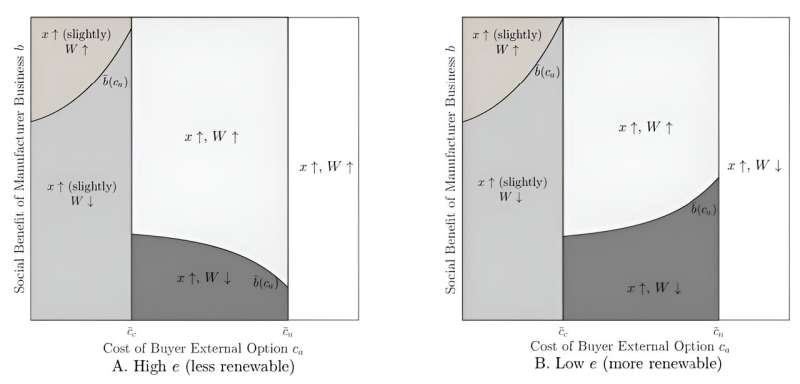This article has been reviewed according to Science X's editorial process and policies. Editors have highlighted the following attributes while ensuring the content's credibility:
fact-checked
trusted source
proofread
Energy-cutting efforts by big firms, partners see mixed results

New research from the University of Oregon and Western University has shed more light on the social effects of large corporations working directly with smaller, overseas manufacturers to make their processes more climate friendly.
Such partnerships, known as buyer collaborations, are sometimes used by businesses like Amazon and Walmart to increase energy efficiency and reduce environmental impacts. The research by the UO and Western University in Canada evaluated economic and social effects of such partnerships and found mixed benefits.
"Buyer collaboration enhances energy efficiency investments, but through our analysis, we found that the impact on social welfare varies," explained co-author Behrooz Pourghannad, assistant professor of operations and business analytics at the UO's Lundquist College of Business.
Pourghannad conducted the study alongside Jason Nguyen from the Ivey Business School at Western University, Canada. It is posted to the SSRN server.
As the effects of climate change become an increasingly urgent challenge, large corporate buyers are actively collaborating with their manufacturing partners to make their processes more energy-efficient. Such partnerships aim both to reduce energy consumption and improve social welfare.
Pourghannad and Nguyen developed a model to help governments and third-party organizations who that support energy-efficient improvements assess the effectiveness of their policies and practices.
Sometimes, efforts to improve energy efficiency can have unexpected negative impacts effects on small manufacturers, the researchers found. For example, after partnering with manufacturers directly to share knowledge and adopt energy-efficient practices, large buyers could use the knowledge gained to negotiate lower prices, and ultimately decrease the revenue to the manufacturer. They may even switch to another manufacturer if they do not find the current manufacturer to be cost-competitive.
"These can lead to small-to-medium manufacturers failing and taking local jobs with them," Pourghannad explained. "This is particularly the case when there are no long-term contracts."
However, these such partnerships can be beneficial when long-term contracts are in place between large buyers and small- to- medium manufacturers. This allows enough time for the manufacturers to recoup the costs of their efficiency investments, resulting in increased revenue for the manufacturer and a reduction in carbon dioxide emissions.
The research is available as a working paper in the SSRN Electronic Journal.
More information: Jason Nguyen et al, Empowering Supply Chain Energy Efficiency: Merits and Pitfalls of Buyer Collaboration, SSRN Electronic Journal (2023). DOI: 10.2139/ssrn.4577708














